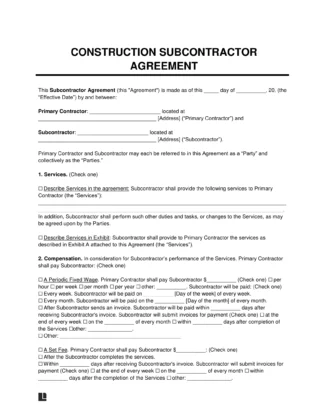Construction Subcontractor Agreement Template
Use a Construction Subcontractor Agreement to outsource work for your construction project.

Updated May 16, 2024
Written by Ioana Gagiuc | Reviewed by Brooke Davis
A construction subcontractor agreement is a document that governs the relationship between a primary contractor and a subcontractor hired for construction projects through a prime contract. This agreement outlines the terms and conditions under which the subcontractor will perform specific tasks or services related to the project.
- Construction Subcontracts By Type
- How to Hire a Construction Subcontractor
- What to Include in a Construction Subcontractor Agreement
- Construction Subcontractor Agreement Sample
Construction Subcontracts By Type
- Concrete
- Painting
- Roofing
- Electrical
- HVAC
- Janitorial
- Solar Panel
- Drywall
- Repair / Maintenance
- Preparing and excavating job sites
How to Hire a Construction Subcontractor
The process of hiring a subcontractor for construction involves several steps:
- Identification of needs. The primary contractor must first assess the project’s requirements and identify the specific tasks or trades where subcontractors are needed.
- Request for proposals. Once the needs are identified, the primary contractor issues a request for proposals (RFP) to potential subcontractors, detailing the scope of work, project timeline, and other relevant information.
- Evaluation and selection. The primary contractor evaluates the proposals from subcontractors and selects the most suitable one based on expertise, experience, cost, and previous work performance.
- Negotiation and agreement. After selecting a subcontractor, the primary contractor negotiates the terms of the agreement, including payment terms, project milestones, and responsibilities.
- Execution. Once both parties agree on the terms, they sign the agreement, making it legally binding.
Each element in the contract provides information needed to define the working relationship. Excluding the information above may lead to issues, disagreements, and other problems during the job duration.
What to Include in a Construction Subcontractor Agreement
A comprehensive agreement should include the following elements:
- Names and contact information. Include this information for both the primary contractor and subcontractor.
- Project details. Include the project name, location, and a brief description of the scope of work.
- Scope of work. Provide a detailed description of the tasks or services the subcontractor will perform.
- Timeline and milestones. Clearly define the project start and end dates and any crucial milestones or deadlines.
- Payment terms. Specify the payment amount, schedule, and payment method for the subcontractor’s services.
- Change order process. Include a well-defined process for handling change orders, including how they will be initiated, assessed, and approved.
- Dispute resolution. Include a clause that outlines the procedure for resolving disputes between the parties.
- Termination clause. Define the conditions under which either party may terminate the agreement.
- Insurance and liability requirements. Require the subcontractor to have appropriate insurance coverage for their work, including liability insurance.
- Indemnification clause. Incorporate an indemnification clause to hold the subcontractor accountable for any damages, claims, or losses resulting from their actions or omissions during the project.
- Confidentiality and non-disclosure.If necessary, include provisions to protect sensitive information and trade secrets, ensuring the subcontractor maintains confidentiality throughout the project.
These elements will help everyone know the expectations and obligations of their role. With everything in writing, you can address issues without disagreements or delays in the project.


